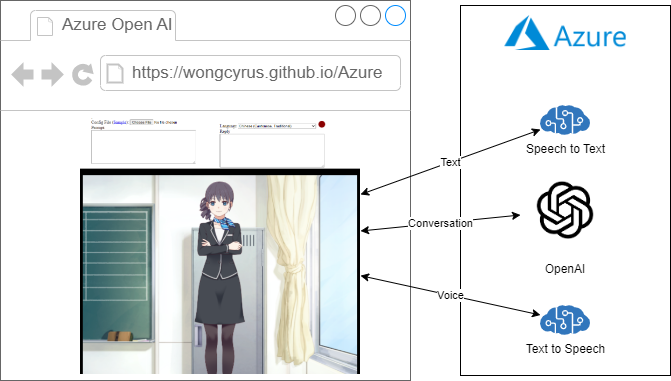Build Your Own Voice Assistant: OpenAI's New Tools Unveiled

Table of Contents
Understanding OpenAI's New Tools for Voice Assistant Development
OpenAI's latest suite of tools significantly simplifies the development of sophisticated voice assistants. By combining these powerful technologies, you can create a truly personalized and intelligent experience. Let's delve into the key components:
Whisper API: Revolutionizing Speech-to-Text Conversion
The Whisper API is a game-changer for voice assistant development. Its robust speech-to-text capabilities form the crucial foundation of any effective voice assistant.
- High accuracy transcription even in noisy environments: Whisper boasts impressive accuracy, making it reliable even in less-than-ideal audio conditions. This is crucial for real-world applications where background noise is common.
- Support for multiple languages: Whisper's multilingual support expands the potential reach of your voice assistant, making it accessible to a global audience. This opens up opportunities to create voice assistants for diverse communities.
- Efficient and cost-effective for large-scale applications: Designed for scalability, Whisper is cost-effective, making it suitable for both personal projects and large-scale deployments.
- Easy integration with existing workflows: Seamless integration with other systems and workflows simplifies the development process. This makes building your voice assistant faster and less complex.
GPT Models: Powering the Brains of Your Voice Assistant
The intelligence behind your voice assistant comes from OpenAI's powerful GPT models. GPT-3.5-turbo and GPT-4 provide the natural language understanding and generation capabilities necessary for engaging conversations.
- Leveraging GPT-3.5-turbo and GPT-4 for natural language understanding: These models excel at understanding the nuances of human language, enabling your assistant to interpret complex requests and subtle cues.
- Creating context-aware and personalized responses: GPT models can maintain context throughout a conversation, providing relevant and personalized responses. This is key for creating a truly natural and engaging user experience.
- Generating human-like text for seamless conversation: The output generated by GPT models is remarkably human-like, making the interaction feel natural and intuitive.
- Adapting to different user personalities and communication styles: With further training and customization, you can tailor your voice assistant to adapt to different user preferences and communication styles.
OpenAI's Embeddings: Enhancing Context and Understanding
OpenAI's embeddings add another layer of intelligence by creating semantic representations of user input. This improves the overall understanding and functionality of your voice assistant.
- Creating semantic representations of user input: Embeddings translate user input into numerical vectors that capture the meaning and context of the words.
- Improving search functionality within your voice assistant: This allows your voice assistant to provide more accurate and relevant search results.
- Enabling more relevant and helpful responses: By understanding the semantic meaning, your assistant can provide more insightful and helpful responses.
- Facilitating personalized recommendations and information retrieval: Embeddings are crucial for delivering personalized recommendations and retrieving relevant information based on user context.
Step-by-Step Guide: Building Your Own Voice Assistant
Building your own voice assistant may seem daunting, but by breaking it down into manageable steps, the process becomes significantly more approachable.
Choosing the Right Tools and Technologies
The foundation of your voice assistant lies in the right technology choices.
- Selecting appropriate programming languages (Python recommended): Python's extensive libraries and ease of use make it a popular choice for AI and machine learning projects.
- Utilizing cloud platforms like AWS, Google Cloud, or Azure for scalability: Cloud platforms provide the scalability and infrastructure needed to handle the demands of a voice assistant.
- Integrating with other APIs for extended functionality (e.g., calendar, email): Integrate with other APIs to expand your assistant's capabilities and allow it to perform tasks like scheduling appointments or sending emails.
Designing the User Interaction and Conversational Flow
A well-designed user interface is essential for a positive user experience.
- Creating intuitive voice commands and responses: Design simple, clear voice commands and ensure the responses are easily understood.
- Implementing error handling and fallback mechanisms: Handle potential errors gracefully, providing helpful feedback to the user when the assistant doesn't understand.
- Designing for a seamless and engaging user experience: Focus on creating a natural and intuitive conversational flow that keeps users engaged.
Testing and Iterative Improvement
Testing is crucial for identifying and fixing issues and refining your assistant's capabilities.
- Thorough testing with diverse users and scenarios: Test your voice assistant with a variety of users and in different scenarios to identify potential problems.
- Collecting user feedback for continuous improvement: Gather user feedback to understand areas for improvement and iterate on your design.
- Iteratively refining the model and conversational flow: Continuously refine your voice assistant based on user feedback and testing results.
Real-World Applications and Future Possibilities of Custom Voice Assistants
The applications for custom voice assistants are vast and constantly expanding.
Personalized Healthcare Management
- Medication reminders: Assist with medication adherence by sending timely reminders.
- Appointment scheduling: Schedule and manage healthcare appointments seamlessly.
- Health data tracking: Help track health data and provide insights.
Smart Home Automation
- Controlling lights, temperature, and appliances: Control various aspects of your smart home through voice commands.
- Integrating with smart home devices: Seamlessly integrate with existing smart home devices.
- Personalized automation routines: Create personalized routines to automate tasks.
Enhanced Accessibility Features
- Voice-controlled navigation for visually impaired users: Provide voice-guided navigation assistance for those with visual impairments.
- Text-to-speech and speech-to-text for communication assistance: Assist users with communication challenges through text-to-speech and speech-to-text functionalities.
- Personalized learning tools for individuals with learning disabilities: Tailor learning experiences to the specific needs of individuals with learning disabilities.
Conclusion
OpenAI's new tools have significantly lowered the barrier to entry for creating sophisticated voice assistants. By leveraging the power of Whisper, GPT models, and embeddings, you can build a personalized voice assistant tailored to your specific needs. This guide has provided a foundational understanding of the process, equipping you to embark on your journey of building your own voice assistant. Start exploring OpenAI's resources and begin building your own personalized intelligent companion! Don't hesitate – start building your own voice assistant today!

Featured Posts
-
 Microsoft Activision Deal Ftcs Appeal And Future Uncertainty
Apr 29, 2025
Microsoft Activision Deal Ftcs Appeal And Future Uncertainty
Apr 29, 2025 -
 Rapid Wien Fans Und Krankl Draengen Nach Klaus Aus Auf Pacult
Apr 29, 2025
Rapid Wien Fans Und Krankl Draengen Nach Klaus Aus Auf Pacult
Apr 29, 2025 -
 How You Tube Is Attracting And Engaging Older Viewers
Apr 29, 2025
How You Tube Is Attracting And Engaging Older Viewers
Apr 29, 2025 -
 Nyt Spelling Bee Answers For February 25 2025 Complete Guide
Apr 29, 2025
Nyt Spelling Bee Answers For February 25 2025 Complete Guide
Apr 29, 2025 -
 Mwedna Me Fn Abwzby 19 Nwfmbr
Apr 29, 2025
Mwedna Me Fn Abwzby 19 Nwfmbr
Apr 29, 2025
